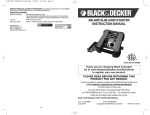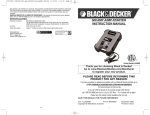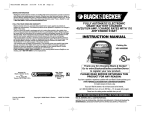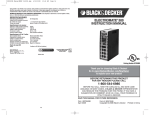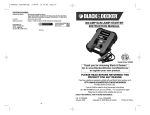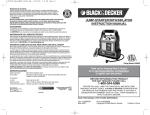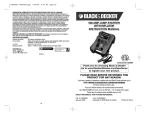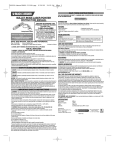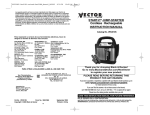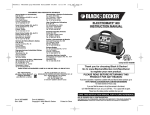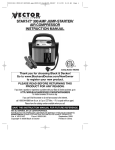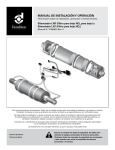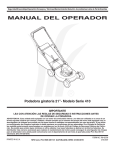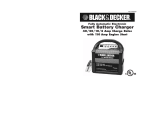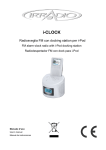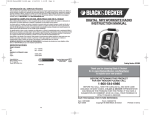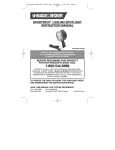Download BC40EWB ManualENSP 022908.qxp
Transcript
BC40EWB ManualENSP 022908.qxp 9/26/08 11:21 AM Page 20 GARANTÍA COMPLETA DE CINCO AÑOS PARA USO EN EL HOGAR Black & Decker (Estados Unidos) Inc. ofrece una garantía de cinco años por cualquier defecto del material o de fabricación de este producto. El producto defectuoso se reparará o reemplazará sin costo alguno de dos maneras. La primera opción, el reemplazo, es devolver el producto al comercio donde se lo adquirió (siempre y cuando se trate de un comercio participante). Las devoluciones deben realizarse conforme a la política de devolución del comercio (generalmente, entre 30 y 90 días posteriores a la venta). Le pueden solicitar comprobante de compra. Consulte en el comercio acerca de la política especial sobre devoluciones una vez excedido el plazo establecido. La segunda opción es llevar o enviar el producto (con flete pago) a un Centro de mantenimiento propio o autorizado de Black & Decker para su reparación o reemplazo según nuestro criterio. Le pueden solicitar comprobante de compra. Encontrará una lista de los Centros de mantenimiento autorizados y de propiedad de Black & Decker bajo "Herramientas eléctricas" (Tools-Electric) en las páginas amarillas de la guía telefónica y también en nuestro sitio Web www.blackanddecker.com. Esta garantía no se extiende a los accesorios. Esta garantía le concede derechos legales específicos; usted puede tener otros derechos que pueden variar según el estado o la provincia. Si tiene alguna pregunta, comuníquese con el Centro de mantenimiento de Black & Decker más cercano. Este producto no está diseñado para uso comercial. REEMPLAZO GRATUITO DE LA ETIQUETA DE PRECAUCIONES: Si sus etiquetas de advertencia se vuelven ilegibles o faltan, llame al 1-800-544-6986 para que se le reemplacen gratuitamente. 40 AMP FULLY AUTOMATIC BATTERY CHARGER WITH 110 AMP ENGINE START INSTRUCTION MANUAL ESPECIFICACIONES Entrada: Salida: 120V CA, 60 Hz, 785 Vatios continuos 120V CA, 60 Hz, 1500 Vatios Comienzo del Motor 12V CC, 40 amps continuos Comienzo del motor de 75 amperios, 5 segundos encendido, 5 minutos apagado Importadod por Black & Decker (U.S.) Inc., 701 E. Joppa Rd. Towson, MD 21286 U.S.A. RD022908 Catalog Number BC40EWB Thank you for choosing Black & Decker! Go to www.BlackandDecker.com/NewOwner to register your new product BEFORE RETURNING THIS PRODUCT FOR ANY REASON PLEASE CALL 1-800-544-6986 BEFORE YOU CALL, HAVE THE CATALOG No, AND DATE CODE AVAILABLE. IN MOST CASES, A BLACK & DECKER REPRESENTATIVE CAN RESOLVE THE PROBLEM OVER THE PHONE. IF YOU HAVE A SUGGESTION OR COMMENT, GIVE US A CALL. YOUR FEEDBACK IS VITAL TO BLACK & DECKER. SAVE THIS MANUAL FOR FUTURE REFERENCE. Cat. # BC40EWB February 2008 20 Form # 90532412 Copyright © 2008 Black & Decker Printed in China 1 BC40EWB ManualENSP 022908.qxp 9/26/08 11:21 AM Page 2 SAFETY GUIDELINES / DEFINITIONS DANGER: Indicates an imminently hazardous situation which, if not avoided, will result in death or serious injury. WARNING: Indicates a potentially hazardous situation which, if not avoided, could result in death or serious injury. CAUTION: Indicates a potentially hazardous situation which, if not avoided, may result in minor or moderate injury. CAUTION: Used without the safety alert symbol indicates potentially hazardous situation which, if not avoided, may result in property damage. RISK OF UNSAFE OPERATION. When using tools or equipment, basic safety precautions should always be followed to reduce the risk of personal injury. Improper operation, maintenance or modification of tools or equipment could result in serious injury and property damage. There are certain applications for which tools and equipment are designed. Black & Decker strongly recommends that this product NOT be modified and/or used for any application other than for which it was designed. Read and understand all warnings and operating instructions before using any tool or equipment. IMPORTANT SAFETY INSTRUCTIONS GENERAL SAFETY WARNINGS AND INSTRUCTIONS FOR ALL APPLIANCES READ ALL INSTRUCTIONS READ ALL INSTRUCTIONS WARNING: Read all instructions before operating product. Failure to follow all instructions listed below may result in electric shock, fire and/or serious injury. • AVOID DANGEROUS ENVIRONMENTS: Don’t use charger in damp or wet locations. Don’t use charger in the rain. • KEEP CHILDREN AWAY. All visitors should be kept at a distance from work area. • STORE IDLE APPLIANCES INDOORS. When not in use, charger should be stored indoors in dry, and high or locked-up place – out of reach of children. • DRESS PROPERLY. Do not wear loose clothing or jewelry. They can be caught in moving parts. Rubber gloves and substantial, non-skid footwear are recommended when working outdoors. Wear protective hair covering to contain long hair. • USE SAFETY GLASSES AND OTHER SAFETY EQUIPMENT. Use safety goggles or safety glasses with side shields, complying with applicable safety standards and, when needed, a face shield. Safety glasses or the like are available at extra cost at your local dealer or Black & Decker Service Center. • DON’T ABUSE CORD. Never carry appliance by cord or yank it to disconnect from receptacle. Keep cord from heat, oil, and sharp edges. • DON’T OVERREACH. Keep proper footing and balance at all times. • DISCONNECT CHARGER. Disconnect the charger from the power supply when not in use and when changing functions. • GROUND FAULT CIRCUIT INTERRUPTER (GFCI) protection should be provided on the circuits or outlets to be used. Receptacles are available having built in GFCI protection and may be used for this measure of safety. • USE OF ACCESSORIES AND ATTACHMENTS. The use of any accessory or attachment not recommended for use with this appliance could be hazardous. Note: Refer to the accessory section of this manual for further details. • STAY ALERT. Watch what you are doing. Use common sense. Do not operate charger when you are tired. • CHECK DAMAGED PARTS. Before further use of the tool, a guard or other part that is damaged should be carefully checked to determine that it will operate properly and perform its intended function. Check for alignment of moving parts, binding of moving parts, breakage of parts, mounting, and any other conditions that may affect its operation. A guard or other part that is damaged should be properly repaired or replaced by an authorized service center unless otherwise indicated elsewhere in this instruction manual. Have defective switches replaced by authorized service center. Do not use tool if switch does not turn it ON and O F F. • DO NOT OPERATE portable electric tools near flammable liquids or in gaseous or explosive atmospheres. Motors in these tools normally spark, and the sparks might ignite fumes. • OUTDOOR USE EXTENSION CORDS. When tool is used outdoors, use only extension cords intended for use outdoors and so marked. • EXTENSION CORDS. Make sure your extension cord is in good condition. When using an extension cord, be sure to use one heavy enough to carry the current your product will draw. An undersized cord will cause a drop in line voltage resulting in loss of power and overheating. The following table shows the correct size to use depending on cord length and nameplate ampere rating. If in doubt, use the next heavier gage. The smaller the gage number, the heavier the cord. Volts 120V 240V Ampere Rating More Not more Than Than 0 6 6 10 10 12 12 16 Minimum Gage for Cord Sets Total Length of Cord in Feet 0-25 26-50 51-100 (0-7,6m) (7,6-15,2m) (15,2-30,4m) 0-50 51-100 101-200 (0-15,2m) (15,2-30,4m) (30,4-60,9m) 101-150 (30,4-45,7m) 201-300 (60,9-91,4m) WARNING: BURST HAZARD: Do not use the unit for charging dry-cell batteries that are commonly used with home appliances. These batteries may burst and cause injury to persons and damage property. Use the unit for charging/boosting a LEAD-ACID battery only. It is not intended to supply power to a low-voltage electrical system other than in a starter-motor application. NEVER EQUALIZE A GEL OR AGM BAT T E RY, these may burst and cause SERIOUS INJURY and property damage. WARNING: SHOCK HAZARD: • If an extension cord is used, make sure that: a) the pins of extension cord are the same number, size and shape as those in the charger, b) the extension cord is properly wired and in good electrical condition, c) the wire size is large enough for the AC rating of the charger as indicated in the table in the previous section. • Do not operate unit with damaged cord or plug; or if the unit has received a sharp blow, been dropped, or otherwise damaged in any way. Do not disassemble the unit; take it to a qualified service technician when service or repair is required. Incorrect reassembly may result in a risk of electric shock or fire, and will void warranty. • Use of an attachment not supplied, recommended or sold by manufacturer specifically for use with this unit may result in a risk of electrical shock and injury to persons. • NEVER submerge this unit in water; do not expose it to rain, snow or use when wet. • To reduce risk of electric shock, disconnect the unit from any power source before attempting maintenance or cleaning. Turning off controls without disconnecting will not reduce this risk. WARNING: RISK OF EXPLOSIVE GASES • Working in the vicinity of a lead acid battery is dangerous. Batteries generate explosive gases during normal battery operation. For this reason, it is of the utmost importance that each time before using the charger you read this manual and follow instructions exactly. • To reduce the risk of battery explosion, follow these instructions and those published by the battery manufacturer and manufacturer of any equipment you intend to use in the vicinity of the battery. Review cautionary markings on these products and on the engine. • This equipment employs parts (switches, relays, etc.) that produce arcs or sparks. Therefore, if used in a garage or enclosed area, the unit MUST be placed not less than 18 inches above the floor. • THIS UNIT IS NOT FOR USE BY CHILDREN AND SHOULD ONLY BE OPERATED BY ADULTS. CAUTION: TO REDUCE THE RISK OF INJURY OR PROPERTY DAMAGE: • Pull cord by plug rather than cord when disconnecting the 120V AC Charging Adapter from the unit. • NEVER ATTEMPT TO JUMP-START OR CHARGE A FROZEN BAT T E RY. • To recharge this unit, use only the supplied AC Charging Adapter. • Vehicles that have on-board computerized systems may be damaged if vehicle battery is jump-started. Before jump-starting, read the vehicle’s owner’s manual to confirm that external-starting assistance is suitable. • When working with lead acid batteries, always make sure immediate assistance is available in case of accident or emergency. • Always have protective eyewear when using this product: contact with battery acid may cause blindness and/or severe burns. Be aware of first aid procedures in case of accidental contact with battery acid. • Have plenty of fresh water and soap nearby in case battery acid contacts skin. • If battery acid contacts skin or clothing, wash immediately with soap and water for at least 10 minutes and get medical attention immediately. • Never smoke or allow a spark or flame in vicinity of vehicle battery, engine or charger. • Remove personal metal items such as rings, bracelets, necklaces and watches when working with a lead acid battery. A lead acid battery can produce a short circuit current high enough to weld a ring, or the like of a metal, causing a severe burn. • Never allow battery acid to come in contact with this unit. • Do not operate this unit in a closed area or restrict ventilation in any way. • FIRST AID – SKIN: If battery acid comes in contact with skin, rinse immediately with water, then wash thoroughly with soap and water. If redness, pain, or irritation occurs, seek immediate medical attention. EYES: If battery acid comes in contact with eyes, flush eyes immediately, for a minimum of 15 minutes and seek immediate medical attention. • LCD Liquid Crystal Display: If liquid crystal comes in contact with your skin: Wash area off completely with plenty of water. Remove contaminated clothing. If liquid crystal gets into your eye: Flush the affected eye with clean water and then seek medical attention. If liquid crystal is swallowed: Flush your mouth thoroughly with water. Drink large quantities of water and induce vomiting. Then seek medical attention. • GROUNDING AND AC POWER CORD CONNECTION INSTRUCTIONS – Charger should be grounded to reduce risk of electric shock. Charger is equipped with an electric cord having an equipment-grounding conductor and a grounding plug. The plug must be plugged into an outlet that is properly installed and grounded in accordance with all local codes and ordinances. American Wire Gage 18 18 16 14 16 16 16 12 16 14 14 12 14 12 Not Recommended WARNING: This product or its power cord contains lead, a chemical known to the State of California to cause cancer and birth defect or other reproductive harm. Wash hands after handling. 2 3 BC40EWB ManualENSP 022908.qxp 9/26/08 11:21 AM Page 4 The battery charger is for use on a nominal 120 volt circuit, and has a grounding plug that looks like the plug illustrated in Figure A. A temporary adapter, which looks like the plug illustrated in Figures B and C may be used to connect this plug to a two-pole receptacle as shown in Figure B if a properly grounded outlet is not available. The temporary adapter should be used only until a properly grounded outlet can be installed by a qualified electrician. DANGER – Before using adapter as illustrated, be certain that the center screw of the outlet is grounded. The green-colored rigid ear or lug extending from the adapter must be connected to a properly grounded outlet. Make certain it is grounded. If necessary, replace the original outlet cover plate screw with a longer screw that will secure adapter ear or lug to outlet cover plate and make ground connection to grounded outlet. DANGER – Never alter AC cord or plug provided – if it will not fit outlet, have proper outlet installed by a qualified electrician. Improper connection can result in a risk of an electric shock. Preparing to Charge 1. Determine voltage of battery to be charged by referring to the vehicle manual. 2. If it is necessary to remove battery from vehicle to charge, or to clean terminals, always remove grounded terminal from battery first. Make sure all accessories in the vehicle are off, so as not to cause an arc. 3. Clean battery terminals. Do not allow corrosion to come in contact with eyes. 4. Add distilled water in each cell until battery acid reaches level specified by battery manufacturer. This helps purge excessive gas from cells. Do not overfill. For a battery without cell caps (maintenance free), carefully follow manufacturer's charging instructions. 5. Study all battery manufacturer’s specific precautions, such as removing or not removing cell caps while charging, and recommended rates of charge. 6. Remove battery completely from boat/airplane or any confined area before charging. 7. Make sure the initial charging rate does not exceed battery manufacturer’s requirement. Charger Location 1. Locate charger as far away from battery as cables permit. 2. NEVER place charger directly above battery being charged; gases from battery will corrode and damage charger. 3. NEVER allow battery acid to drip on charger when reading gravity or filling battery. 4. NEVER operate charger in a closed-in area or restrict ventilation in any way. 5. Marine batteries must be removed and charged on shore. 6. Do not set a battery on top of charger. DC Connection Precautions 1. Connect and disconnect DC output clamps only after removing AC cord from electric outlet. 2. Never allow clamps to touch each other. 3. Attach clamps to battery and chassis as indicated in “Battery Installed in Vehicle” steps 5 and 6, and in “Battery Outside of Vehicle” steps 2, 4 and 5. CAUTION: A spark near the battery may cause an explosion. Follow these steps to reduce the risk of a spark near the b a t t e ry when the battery is installed in a vehicle: 1. Position AC and DC cords away from hood, door, or moving engine parts. 2. Stay clear of fan blades, belts, pulleys, and other parts that can cause injury to persons. 3. Check polarity of battery posts. POSITIVE (POS, P, +) battery post usually has larger diameter than NEGATIVE (NEG, N, –) post. 4. Determine which post of battery is grounded (connected) to the chassis. If negative post is grounded to chassis (as in most vehicles), see 5. If positive post is grounded to the chassis, see 6. 5. For negative-grounded vehicle, connect POSITIVE (RED) clamp from battery charger to POSITIVE (POS, P, +) ungrounded post of battery. Connect NEGATIVE (BLACK) clamp to vehicle chassis or engine block away from battery. Do not connect clip to carburetor, fuel lines, or sheet-metal body parts. Connect to heavy gauge metal part of the frame or engine block. 6. For positive-grounded vehicle, connect NEGATIVE (BLACK) clamp from battery charger to NEGATIVE (NEG, N, –) ungrounded post of battery. Connect POSITIVE (RED) clamp to vehicle chassis or engine block away from battery. Do not connect clip to carburetor, fuel lines or sheet-metal body parts. Connect to a heavy gauge metal part of the frame or engine block. 7. When disconnecting charger, disconnect AC cord, remove clamp from vehicle chassis, and then remove clamp from battery terminal. 8. Do not charge the battery while the engine is operating. 9. See operating instructions for length of charge information. CAUTION: A spark near the battery may cause an explosion. Follow these steps to reduce the risk of a spark near the battery when the battery has been removed from a vehicle: 1. Check polarity of battery posts. POSITIVE post (marked POS, P, +) usually has a larger diameter than the N E G ATIVE b a t t e ry post (marked NEG, N, –). 2. Attach a 24-inch (minimum length) 8 AWG insulated battery cable to the NEGATIVE battery post (marked NEG, N, – or BLACK). 3. Connect the POSITIVE (RED) battery clamp to the P O S I T I V E battery post (marked POS, P, + or R E D) . 4. Stand as far back from the battery as possible, and do not face battery when making final connection. 5. Carefully connect the NEGATIVE (BLACK) charger clamp to the free end of the battery cable connected to the N E G ATIVE terminal. 6. Press the Charge Button. 4 7. When disconnecting charger, always do so in reverse sequence of connecting procedure and break first connection while as far away from battery as practical. Note: A marine (boat) battery must be removed and charged on shore. To charge it on board requires equipment specially designed for marine use. This unit is NOT designed for such use. • Check unit periodically for wear and tear. Take to a qualified technician for replacement of worn or defective parts immediately. • Read And Understand This Instruction Manual Before Using This Unit. SAVE THESE INSTRUCTIONS This device complies with part 15 of the FCC rules. Operation is subject to the following two conditions: (1) This device may not cause harmful interference, and (2) This device must accept any interference received, including interference that may cause undesired operation. This equipment has been tested and found to comply with the limits for a Class B digital device, pursuant to part 15 of the FCC Rules, These limits are designed to provide reasonable protection against harmful interference to radio communications. However, there is not guarantee that interference to radio or television reception, with can be determined by turning the equipment off and on, user is encouraged to try to connect the interference by one or more of the following measures: • Reorient or relocate the receiving antenna. • Increase the separation between equipment and receiver. • Connect equipment into an outlet on a circuit different from that to which the receiver is connected. • Consult the dealer or an experienced radio/TV technician for help. WARNING: TO REDUCE THE RISK OF INJURY: Follow these instructions and those published by the battery manufacturer and manufacturer of any equipment you intend to use with this unit. Review cautionary markings on these products and on engine. INTRODUCTION Thank you for selecting the Black & D e c k er® 40 Amp Smart™ B a t t e ry Charger. With proper care and use, it will give you years of dependable service. This battery charger has a high charge rate of up to 40 amps and 110 amps of engine starting power. Smart™ Battery Chargers feature 3-stage, high-efficiency charging technology, built-in microprocessor control that ensures fast, safe and complete charging of serviceable batteries. S TAGE ONE BEEP BEEP Charge Curve STAGE TWO S TAGE THREE OFF BEEP CHARGING COMPLETE Stage One — Rapid Start Charge at 40 amps delivers maximum charging amperage to “wake up” any serviceable 12 volt battery and allows for quick engine starting. When battery reaches a maximum safe predetermined voltage, the charger will automatically signal a "beep" and move into Stage 2 of the charging process. Stage Two — Absorption Charge maintains the maximum possible charge at a constant, safe, predetermined voltage. During this phase, the charging voltage remains constant, while the actual charging current is reduced to allow for the maximum proper internal chemical energy transfer. At the end of Stage 2, the charger will automatically move into Stage 3 charge mode. Stage Three — Top-Off Charge voltage is automatically maintained and reduced to a predetermined level while current is adjusted for a safe, effective battery charge. At the end of Stage 3, the unit will BEEP signaling the completion of the charging cycle. The Automatic Float Charge feature is ideal for maintaining a battery. It automatically tops off battery as needed, keeping it fully charged all the time. FEATURES • Unit automatically selects the proper charge rate setting • 3-stage high-frequency switch mode automatic rapid charging • 1 1/2-minute, 110 amp engine start • Automatic Temperature Compensation • Digital diagnostics • Alternator voltage and battery voltage check • Digital display shows operating mode, fault conditions and indicates when battery is charged • Spark resistant reverse polarity and short circuit protection for user • Built-in battery reconditioning (desulfate) • Lightweight, high-efficiency design • Internal short circuit protection • Cables and clamps self-stored • Reverse polarity indication 5 BC40EWB ManualENSP 022908.qxp 9/26/08 11:21 AM Page 6 • Microprocessor control (Digital Smart Control)/High frequency power • Compensates for low AC from extension cord use Control Panel 7. To exit Float Charging Mode, press the Charge button. STANDBY will display on the LCD and the unit will be in Standby Mode (described at the end of this section). Then disconnect the AC cord and clamps, observing the “Important Safety Instructions” at the front of this manual. Engine Start Function Buttons Charge analyzes the battery and starts the recharging process. If the battery is fully charged, this button will place the unit in Float Charge Mode. Pressing this button a second time will place the unit in Standby Mode. B a t t e ry Voltage is a quick check that measures the battery voltage. B a t t e ry Recondition is an automatic mode that, once started, continues for 24 hours and then stops. A series of electrical pulses breaks the crystalline form of lead sulfate to return these chemicals into useful battery electrolytes. More than 24 hours may be needed to restore. Periodic reconditioning is recommended to maintain a battery's optimum performance. However, if 2 cycles does not improve battery performance, discontinue and recycle the battery. Alternator Check checks to determine that the alternator is keeping up with the electrical load. Engine Start places the charger in an engine start sequence. The Engine Start function can supply 110 amps for engine starting. 1. Set up the unit as described in the “Setting Up the Unit” section. 2. When the WELCOME message displays on the LCD, first press the Charge button on the control panel, then press the Engine Start button. 3. The LCD will show a 90-second count down (90 SECONDS), then READY TO START ENGINE will display. 4. Crank the engine using manufacturer’s guidelines, typically in 3 to 5 second bursts. The LCD displays STA RTING. The high current engine starting function requires a resting/cooling period between tries. The charger will switch back to regular charge Mode after 5 seconds and will not allow operation in this mode for 5 minutes. 5. Wait 5 minutes before a second attempt at starting the engine, if needed. During this period, the LCD will show 2.3A CHARGING. (The amperage is approximate; the unit is actually cooling down.) The unit is actually cooling down. If the Engine Start button is pressed during this period, COOL DOWN WAIT 5 MINUTES will display. To crank engine again, repeat steps 2 to 4. 6. After the engine starts, press the Charge button. STANDBY will display on the LCD and the unit will be in Standby Mode (described at the end of this section). Then disconnect the AC cord and clamps, observing the “Important Safety Instructions” at the front of this manual. Reconditioning the Battery Ensure that all installation and operating instructions and safety precautions are understood and carefully followed by anyone installing or using the charger. Follow the steps outlined in the “Important Safety Instructions” section of this manual. After charger clamps are correctly connected, plug in the charger into a functioning 120 volt AC outlet. The Digital Display LCD will show WELCOME, indicating that the unit is set up properly and ready to use. Note: The LCD displays No Battery Connected when the unit is turned on and there is no battery connected to the charger. If there is a problem with the connections or battery, the LCD will display a Fault Condition message. Refer to the “Troubleshooting” section of this Instruction Manual and take the appropriate action. Whenever a lead-acid battery begins to discharge, lead sulfate, an insulator, begins to build up on the battery ’s internal plates. This reduces the ability of the battery to hold a full charge. When that battery has an immediate charge, most of the lead sulfate is dissolved and the plates are free of this insulation. If a battery remains in a discharged condition over a longer period of time, the lead sulfate changes to a hard crystalline form, making a full charge difficult to achieve. Reconditioning may “save” a sulfated battery. B a t t e ryRecondition Mode should only be used with 10 Amp Hour (Ah) or larger capacity lead-acid batteries. Charge the battery to be treated for 20 minutes (as outlined in the “Charging the Battery” section), before using Recondition Mode. Observe the Digital Display for any Fault Condition messages. This initial charge will check the battery for shorted cells, open cells or battery too low to accept a charge, and to ensure the battery can take a charge. CAUTION: Remove or disconnect the vehicle’s battery when reconditioning. 1. When the WELCOME message displays on the LCD, press the Battery Recond. button on the Control Panel to start the process. 2. RECONDITIONING BAT T E RY shows on the LCD display. 3. The process takes 24 hours and stops automatically. The display shows “RECONDITIONING CYCLE COMPLETED” when the process is complete. 4. To turn off the unit, press the Recondition button again. STANDBY will display on the LCD and the unit will be in Standby Mode (described at the end of this section). Then disconnect the AC cord and clamps, observing the “Important Safety Instructions” at the front of this manual. Charging the Battery Alternator Check 1. Set up the unit as described in the “Setting Up the Unit” section. 2. When the WELCOME message displays on the LCD, press the Charge button on the Control Panel. 3. Analyzing Battery will display on the LCD. 4. When the unit is done analyzing the battery, it will begin the recharging process. The LCD will then display the charge rate (for example: 10.8 A CHARGING). 5. When the unit is fully charged, the LCD displays BAT T E RY FULLY CHARGED. 6. Disconnect the AC cord and clamps. Note: Once the battery is fully charged, the unit will not automatically shut off. It will go into Float Charging Mode. You must press the Charge button again. STANDBY will display on the LCD and the unit will be in Standby Mode (described at the end of this section). Then disconnect the AC cord and clamps to shut the unit off. Observe the “Important Safety Instructions” at the front of this manual when disconnecting. Part 1 No Load (Turn OFF all vehicle’s accessories): The battery must be fully charged before testing the alternator. Run the engine long enough to achieve normal idle speed and verify there is a no-load voltage. 1. Set up the unit as described in the “Setting Up the Unit” section. 2. When the WELCOME message displays on the LCD, press the Alternator Check button on the Control Panel to start the process. The LCD shows ALTERNATOR CHECK. 3. Once the unit has finished checking, the LCD will display either ALTERNATOR VOLTAGE GOOD or ALTERNATOR VOLTAGE BAD. 4. Press Alternator Check again to stop the test. Part 2 Under Load (Accessories ON): Next, load the alternator by turning on as many accessories as possible (except for A/C and DEFROST) and repeat the above four steps. After completing both alternator checks, turn the unit off by pressing the Alternator Check button again. STANDBY will display on the LCD and the unit will be in Standby Mode (described at the end of this section). Then disconnect the AC cord and clamps, observing the “Important Safety Instructions” at the front of this manual. If the first alternator check indicates a good alternator and the second indicates the alternator is not good, the problem could stem from: loose fan belts, an intermittent diode failure or possibly bad connections between the battery and alternator and/or ground. ALTERNATOR VOLTAGE BAD may display because someone has added a number of accessory loads on the charging system, thereby increasing current demand from the alternator. MAKE SURE THAT THE ALTERNATOR IS RATED TO SUPPORT THE APPLICATION. Note: This check may not be accurate for every make, manufacturer and model of vehicle. Check only 12 volt systems. 7 Scrolling Message LCD Display The Scrolling Message LCD Display (LCD) in the upper left of the control panel indicates the various conditions and/or status messages as described in the Operating Instructions section that follows. OPERATING INSTRUCTIONS Setting Up the Unit Automatic Float Charging Automatic Float Charging is ideal for maintaining a fully charged battery. It automatically tops off the battery as needed to keep the battery fully charged all the time. 1. Set up the unit as described in the “Setting Up the Unit” section. 2. When the WELCOME message displays on the LCD, press the Charge button on the Control Panel. 3. Analyzing Battery will display on the LCD. If the battery requires charging, the unit will automatically go into Charging Mode as described in the previous section. 4. After the LCD displays BATTERY FULLY CHARGED, the unit will go into Float Charging Mode. 5. Keep the AC power and battery connected after battery is fully charged. 6. The charger monitors the battery and tops it off as needed. 6 BC40EWB ManualENSP 022908.qxp 9/26/08 11:21 AM Page 8 Standby Mode FULL FIVE-YEAR HOME USE WARRANTY Always place the unit in Standby Mode before disconnecting the AC cord and clamps (see individual functions for directions). Placing the unit in Standby Mode does NOT turn the unit off. If left connected to a battery in Standby Mode, the unit will automatically turn on again in approximately 1 minute. The AC cord and clamps must be disconnected to turn the unit off. Black & Decker (U.S.) Inc. warrants this product for five years against any defects in material or workmanship. The defective product will be replaced or repaired at no charge in either of two ways. The first, which will result in exchanges only, is to return the product to the retailer from whom it was purchased (provided that the store is a participating retailer). Returns should be made within the time period of the retailer’s policy for exchanges (usually 30 to 90 days after the sale). Proof of purchase may be required. Please check with the retailer for their specific return policy regarding returns that are beyond the time set for exchanges. The second option is to take or send the product (prepaid) to a Black & Decker owned or authorized Service Center for repair or replacement at our option. Proof of purchase may be required. Black & Decker owned and authorized Service Centers are listed under "Tools-Electric" in the yellow pages of the phone directory and on our websitewww. b l a c k a n d d e c k e r.com. This warranty does not apply to accessories. This warranty gives you specific legal rights and you may have other rights which v a ry from state to state or province to province. Should you have any questions, contact the manager of your nearest Black & Decker Service Center. This product is not intended for commercial use. FREE WARNING LABEL REPLACEMENT: If your warning labels become illegible or are missing, call 1-800-544-6986 for a free replacement. TROUBLESHOOTING Fault Conditions If there is a problem with the connections or battery, the LCD will display the appropriate fault condition message, as follows: Fault Message Explanation/Recommendation REVERSE POLARITY (displays and the unit beeps once) The connections to the battery ’s positive and negative terminals are incorrect. O b s e rving the “Important Safety Instructions” at the front of this manual, disconnect AC cord and clamps and reconnect to battery with correct polarity. INTERNAL OPEN CELL OR SULFATED CONDITION The battery being charged either has an internal open cell or is highly sulfated and cannot accept normal charge current. • Follow the steps in “Reconditioning the Battery” to recondition the battery. • If the situation persists after reconditioning, we recommend taking your battery to a certified automotive service center for evaluation The battery being charged has an internal shorted cell and cannot accept normal charge current. We recommend taking your battery to a certified automotive s e rvice center for evaluation. INTERNAL SHORTED CELL BAT T E RY OVERHEAT CONDITION NO BAT T E RY CONNECTED The ventilation grill that prevents the air from flowing in and out of the charger may be blocked. • O b s e rving the “Important Safety Instructions” at the front of this manual, disconnect AC cord and clamps, allow the unit to cool for 30 minutes and reconnect. • Make sure there is ample ventilation before resuming operation. When this message appears, the most common cause is poor connection to battery. • O b s e rving the “Important Safety Instructions” at the front of this manual, disconnect AC cord and clamps, clean battery terminal and reconnect. • If the situation persists, we recommend taking your battery to a certified automotive service center for evaluation. SPECIFICATIONS Input: Output: 120V AC, 60 Hz, 785 Watts Continuous 120V AC, 60 Hz, 1500 Watts Engine Start 12V DC, 40 Amps Continuous 110 Amp Engine Start, 5 Seconds on, 5 minutes off Imported by Black & Decker (U.S.) Inc., 701 E. Joppa Rd. Towson, MD 21286 U.S.A. RD022908 Charging a Very Cold Battery If the battery to be charged is very cold (in temperatures below freezing — 0°C/ 32°F), it cannot accept a high rate of charge. The battery will accept a higher charge rate as it warms. NEVER ATTEMPT TO CHARGE A FROZEN BAT T E RY. CARE AND MAINTENANCE With proper care and minimal maintenance, the 40 Amp Automatic Battery Charger will provide years of dependable service. For maximum performance, manufacturer recommends: • After each use, clean the battery charger clamps — be sure to remove any battery fluid that will cause corrosion of the clamps. • Clean the outside case of the charger with a soft cloth and, if necessary, mild soap solution. • Do not allow liquid to enter the charger. Do not operate when charger is wet. • Keep the charger cords loosely coiled during storage to prevent damage to the cords. WARNINGS: • Do not use charger if cords or clamps have been damaged in any way — call Technical Support toll-free at 1-800-544-6986. • There are no user- s e rviceable parts in this unit. • Do not open the unit. In the event of malfunction, it must be returned to manufacturer for professional testing and repair. Opening the unit will void the manufacturer’s warranty. ACCESSORIES Recommended accessories for use with your tool are available from your local dealer or authorized service center. If you need assistance regarding accessories, please call: 1-800-544-6986. WARNING: The use of any accessory not recommended for use with this tool could be hazardous. SERVICE INFORMATION All Black & Decker Service Centers are staffed with trained personnel to provide customers with efficient and reliable power tool s e rvice. Whether you need technical advice, repair, or genuine factory replacement parts, contact the Black & Decker location nearest you. To find your local service location, refer to the yellow page directory under "Tools—Electric" or call: 1-800-5446986 or visit www.blackanddecker. c o m. 8 9 BC40EWB ManualENSP 022908.qxp 9/26/08 11:21 AM Page 10 CARGADOR DE BATERÍAS COMPLETAMENTE AUTOMÁTICO DE 40 A CON ARRANQUE DEL MOTOR DE 110 A MANUAL DE INSTRUCCIONES Número de catálogo BC40EWB ¡Gracias por elegir Black & Decker! Vaya a www.BlackandDecker.com/NewOwner para registrar su nuevo producto ANTES DE DEVOLVER ESTE PRODUCTO POR CUALQUIER MOTIVO, LLAME AL 1-800-544-6986 ANTES DE LLAMAR, TENGA A MANO EL Nº DE CATÁLOGO Y EL CÓDIGO DE LA FECHA. EN LA MAYORÍA DE LOS CASOS, EL REPRESENTANTE DE BLACK & DECKER PUEDE SOLUCIONAR SU PROBLEMA POR TELÉFONO. SI DESEA REALIZAR UNA SUGERENCIA O COMENTARIO, LLÁMENOS. SU OPINIÓN ES FUNDAMENTAL PARA BLACK & DECKER. CONSERVE ESTE MANUAL PARA FUTURAS CONSULTAS. Nº de Catálogo: BC40EWB Febrero 2008 10 Form # 90532412 Copyright © 2008 Black & Decker Impreso en China 11 BC40EWB ManualENSP 022908.qxp 9/26/08 11:21 AM Page 12 NORMAS DE SEGURIDAD / DEFINICIONES PELIGRO: Indica una situación de peligro inminente que, si no se evita, provocará la muerte o lesiones graves. A D V E RTENCIA: Indica una situación de peligro inminente que, si no se evita, provocará la muerte o lesiones graves. PRECAUCIÓN: Indica una situación de peligro potencial que, si no se evita, puede provocar lesiones leves o moderadas. PRECAUCIÓN: Utilizado sin el símbolo de alerta de seguridad indica una situación de peligro potencial que, si no se evita, puede provocar daños en la propiedad. RIESGO DE OPERACIÓN INSEGURA. Cuando se utilizan herramientas o equipos, siempre se deben respetar las precauciones de seguridad para reducir el riesgo de lesiones personales. La operación, el mantenimiento o la modificación incorrectos de herramientas o equipos pueden provocar lesiones graves y daños a la propiedad. Las herramientas y los equipos están diseñados para determinados usos. Black & Decker recomienda enfáticamente que NO se modifique este producto y que NO se utilice para ningún otro uso que aquél para el que fue diseñado. Lea y comprenda todas las instrucciones operativas y las advertencias antes de utilizar cualquier herramienta o equipo. INSTRUCCIONES IMPORTANTES SOBRE SEGURIDAD A D V E RTENCIAS E INSTRUCCIONES DE SEGURIDAD GENERALES PARA TODOS LOS ARTEFACTOS LEA LAS INSTRUCCIONES A D V E RTENCIA: Lea todas las instrucciones antes de operar el producto. El incumplimiento de todas las instrucciones enumeradas a continuación puede provocar una descarga eléctrica, un incendio o lesiones graves. • EVITE LAS CONDICIONES AMBIENTALES PELIGROSAS. NO utilice el cargador en zonas húmedas o mojadas. No utilice artefactos bajo la lluvia. • MANTENGA A LOS NIÑOS ALEJADOS. Los visitantes deben mantenerse a distancia del área de trabajo. • GUARDE LOS ART E FACTOS QUE NO UTILICE EN EL INTERIOR. Cuando no los utilice, los artefactos deben guardarse en el interior en un lugar seco, alto o bajo llave, lejos del alcance de los niños. • USE LA VESTIMENTA ADECUADA. No use ropas holgadas o joyas. Pueden atascarse en las piezas en movimiento. Se recomienda utilizar guantes de goma y calzado antideslizante considerable al trabajar al aire libre. Recójase y cubra el cabello largo. • UTILICE LAS GAFAS DE SEGURIDAD Y EL OTRO EQUIPO DE SEGURIDAD. Utilice anteojos protectores o lentes de seguridad con protección lateral que cumplan con las normas de seguridad aplicables y, de ser necesario, un protector facial. Utilice también máscaras faciales o para polvo si la operación produce polvillo. Puede conseguir anteojos de seguridad o similares a un costo adicional en su distribuidor local o en el Centro de mantenimiento de Black & Decker. • NO TIRE DEL CABLE. Nunca transporte el aparato por el cable ni lo jale para desconectarlo del tomacorriente. Mantenga el cable alejado del calor, el aceite y los bordes afilados. • NO SE ESTIRE. Conserve el equilibrio y párese adecuadamente en todo momento. • DESCONECTE EL CARGADOR. Desconecte el cargador de la fuente de alimentación cuando no en uso y al cambiar funciones. • La protección del INTERRUPTOR DE CORTE POR FALLA A TIERRA (GFCI) debe aplicarse a los circuitos o los tomacorrientes que se utilizarán. Hay tomacorrientes con protección GFCI incorporada que pueden utilizarse para tomar esta medida de seguridad. • USO DE SUPLEMENTOS Y ACCESORIOS. El uso de accesorios o dispositivos no recomendados para utilizar con este aparato puede resultar peligroso. Nota: Consulte la sección "Accesorios" de este manual para obtener detalles adicionales. • MANTÉNGASE ALERTA. Fíjese en lo que está haciendo. Use el sentido común. No opere la herramienta si está cansado. • VERIFIQUE QUE NO HAYA PIEZAS DAÑADAS. Antes de volver a utilizar la herramienta, se debe controlar cualquier protección u otra pieza que esté averiada para determinar si funcionará correctamente y realizará la función para la que fue diseñada. Verifique la alineación de las piezas móviles, la rotura de piezas, el montaje y cualquier otra condición que pueda afectar su operación. Cualquier protección u otra pieza que esté dañada debe ser reparada correctamente o reemplazada por un centro de mantenimiento autorizado, a menos que este manual de instrucciones indique otra cosa. Reemplace los interruptores defectuosos en un centro de mantenimiento autorizado. No utilice la herramienta si no puede encenderla o apagarla con el interruptor. • NO OPERE herramientas eléctricas portátiles cerca de líquidos inflamables o en atmósferas gaseosas o explosivas. Ciertos componentes en estas herramientas normalmente chispean, y las chispas pueden encender los vapores. • USO DE CABLES PROLONGADORES EN ESPACIOS ABIERT O S . Cuando utilice la herramienta al aire libre, utilice solamente cables prolongadores diseñados para su uso al aire libre o marcados como tales. • CABLES PROLONGADORES. Asegúrese de que el cable prolongador esté en buenas condiciones. Cuando utilice un cable prolongador, asegúrese de que tenga la capacidad para conducir la corriente que su producto exige. Un cable de menor capacidad provocará una disminución en el voltaje de la línea, lo cual producirá una pérdida de potencia y sobrecalentamiento. La siguiente tabla muestra la medida correcta que debe utilizar según la longitud del cable y la capacidad nominal en amperios indicada en la placa. En caso de duda, utilice el calibre inmediatamente superior. Cuanto menor es el número de calibre, más grueso es el cable. 12 Calibre mínimo para los juegos de cables Largo total del cable en pies 0-25 26-50 51-100 (0-7,6 m) (7,6-15,2 m) (15,2-30,4 m) 240V 0-50 51-100 101-200 (0-15,2 m) (15,2-30,4 m) (30,4-60,9 m) Capacidad nominal en amperios Más No más Medida de conductor estadounidense que que 0 6 18 16 16 14 6 10 18 16 14 12 10 12 16 16 14 12 Voltios 120V 101-150 (30,4-45,7 m) 201-300 (60,9-91,4 m) ADVERTENCIA: Este producto o su cable de alimentación contiene plomo, una sustancia química reconocida por el Estado de California como causante de cáncer, defectos de nacimiento u otros problemas reproductivos. Lávese las manos después de utilizarlo. A D V E RTENCIA, PELIGRO DE ESTALLIDO: No utilice la unidad para cargar las baterías secas que se usan normalmente con los aparatos domésticos Estas baterías pueden estallar y provocar lesiones a las personas y daños a la propiedad. Use la unidad para carga/ refuerzo solamente de una batería de PLOMO-ÁCIDO. No está diseñada para proveer energía a un sistema eléctrico de bajo voltaje que no sea para arrancar un motor. RIESGO DE DESCARGA ELÉCTRICA: • No se debe utilizar un cable prolongador a menos que sea absolutamente necesario. Si es necesario utilizar un cable prolongador, asegúrese de que: a) las patas del cable prolongador sean de la misma cantidad, tamaño y forma que las de la batería de refuerzo, b) que el cable prolongador posea los conductores correctos y esté en buenas condiciones eléctricas, c) la medida del conductor es suficientemente grande para la capacidad nominal en amperios como se indicó en la tabla anterior. • No opere la unidad con un cable o enchufe dañados, o si ésta ha recibido un golpe fuerte, se cayó o presenta algún daño. No desarme la unidad; llévela a un técnico de servicio calificado cuando se requiera mantenimiento o una reparación. Volver a armarlo de manera incorrecta podría provocar riesgo de descarga eléctrica o incendio, y anulará la garantía. • El uso de un dispositivo no suministrado, recomendado o vendido por el fabricante específicamente para el uso con esta unidad puede provocar riego de descarga eléctrica y lesiones a las personas. • NUNCA sumerja esta unidad en agua, no la exponga a la lluvia, la nieve ni la use cuando esté mojada. • Para reducir el riesgo de descarga eléctrica, desconecte la unidad de cualquier fuente de alimentación antes de intentar realizarle mantenimiento o limpieza. Apagar los controles sin desenchufar la unidad no reducirá este riesgo. A D V E RTENCIA: RIESGO DE GASES EXPLOSIVOS: • Trabajar cerca de una batería de plomo ácido es peligroso. Las baterías generan gases explosivos durante su funcionamiento normal. Por esta razón, es muy importante que lea este manual siempre antes de utilizar la batería de urgencia y que siga las instrucciones con exactitud. • Para reducir el riesgo de explosión de la batería, siga estas instrucciones y las publicadas por el fabricante de la batería y el fabricante de cualquier equipo que tenga la intención de utilizar cerca de la batería. Revise las indicaciones sobre precauciones en estos productos y en el motor. • Este equipo emplea piezas (interruptores y relés) que producen arcos o chispas. Por lo tanto, si utiliza la unidad en una cochera o un área cerrada, DEBE colocarla a no menos de 46 cm (18 pulgadas) por encima del piso. • PARA REDUCIR EL RIESGO DE LESIONES, ESTA UNIDAD SÓLO DEBE SER OPERADA POR ADULTOS, NO FUE DISEÑADA PARA QUE LA UTILICEN LOS NIÑOS. PRECAUCIÓN: PARA REDUCIR EL RIESGO DE LESIONES O DAÑO A LA PROPIEDAD: • Tire del enchufe y no del cable al desconectar el adaptador de carga de CA de 120 voltios de la unidad. • NUNCA INTENTE ARRANCAR MEDIANTE PUENTE UNA BATERÍA CONGELADA. • Los vehículos que tienen sistemas computarizados incorporados pueden resultar dañados si la batería del vehículo se arranca mediante puente. Antes de arrancar mediante puente, lea el manual del cliente del vehículo para confirmar que la ayuda externa para arrancar es adecuada. • Cuando trabaje con baterías de plomo-ácido, asegúrese de que siempre haya ayuda inmediata disponible en caso de accidente o emergencia. • Utilice siempre protección para los ojos al emplear este producto; el contacto con el ácido de la batería puede producir ceguera o quemaduras graves. Conozca los procedimientos de primeros auxilios para el caso de contacto accidental con el ácido de la batería. • Mantenga cerca suficiente agua fresca y jabón en caso que el ácido de la batería entre en contacto con la piel. • Si el ácido de la batería entra en contacto con la piel o la ropa, enjuáguese inmediatamente con agua y jabón durante por lo menos 10 minutos. Busque asistencia médica de inmediato. • Nunca fume, ni permita que hayan chispas o llamas cerca de la batería del vehículo, del motor o del cargador. • Quítese todos los artículos personales que sean de metal, como anillos, pulseras y relojes cuando trabaje con una batería de ácido de plomo. Una batería de ácido de plomo puede producir una corriente de cortocircuito lo suficientemente alta como para soldar un anillo, o algo parecido al metal, causando así una quemadura severa. 13 BC40EWB ManualENSP 022908.qxp 9/26/08 11:21 AM Page 14 • Nunca permita que el ácido de la batería entre en contacto con esta unidad. • No opere esta unidad en un área cerrada ni restrinja la ventilación de alguna forma. • PRIMEROS AUXILIOS – PIEL: Si el ácido de la batería entra en contacto con la piel, enjuáguese inmediatamente con agua, luego lávese con agua y jabón. Si se presenta enrojecimiento, dolor o irritación, busque asistencia médica de inmediato. OJOS: Si el ácido de la batería entra en contacto con los ojos, lávese los ojos inmediatamente durante 15 minutos como mínimo y busque asistencia médica de inmediato. INDICADOR DE CRISTAL LÍQUIDO DEL LCD: Si es líquido el cristal viene en contacto con su piel: Lave el área apagado totalmente con el un montón de agua. Quite la ropa contaminada. Si es líquido el cristal consigue en su ojo: Limpie el ojo con un chorro de agua afectado con agua limpia y después busque la atención médica. Si es líquido se traga el cristal: Limpie su boca con un chorro de agua a fondo con agua. Beba las cantidades grandes de agua e induzca vomitar. Entonces busque la atención médica. INSTRUCCIONES DE LA CONEXIÓN DE LA CUERDA EL PONER A TIERRA Y DE LA CORRIENTE ALTERNA – el cargador debe ser puesto a tierra para reducir riesgo de la descarga eléctrica. El cargador se equipa de una cuerda eléctrica que tiene un conductor equipo-que pone a tierra y un enchufe que pone a tierra. El enchufe se debe tapar en un enchufe que esté instalado y puesto a tierra correctamente de acuerdo con todos los códigos y ordenanzas locales. El cargador de batería es para el uso en un nominal circuito de 120 voltios, y tiene un enchufe que pone a tierra que parezca el enchufe ilustrado en la figura A. Un adaptador temporal, que los parecer el enchufe ilustraron en las figuras B y C se puede utilizar para conectar este enchufe con un receptáculo del dos-poste según lo demostrado en la figura B si un enchufe correctamente puesto a tierra no está disponible. El adaptador temporal debe ser utilizado solamente hasta que un enchufe correctamente puesto a tierra se puede instalar por un electricista cualificado. PELIGRO – antes de usar el adaptador según lo ilustrado, esté seguro que el tornillo de centro del enchufe está puesto a tierra. El oído o el estirón rígido verde-coloreado que extiende del adaptador se debe conectar con un enchufe correctamente puesto a tierra. Asegúrese él se pone a tierra. En caso de necesidad, substituya el tornillo original de la tapadera del enchufe por un tornillo más largo que asegure el oído del adaptador o arrastre a la tapadera del enchufe y haga la conexión de tierra al enchufe puesto a tierra. PELIGRO – nunca altere la cuerda o el enchufe de la CA proporcionado - si no cabe el enchufe, tiene enchufe apropiado instalado por un electricista cualificado. La conexión incorrecta puede dar lugar a un riesgo de una descarga eléctrica. Preparación para la carga 1. Determine el voltaje de la batería que se va a cargar consultando el manual del vehículo. 2. Si es necesario retirar la batería del vehículo para cargarla, o para limpiar los terminales, retire siempre primero de la batería el terminal puesto a tierra. Asegúrese de que todos los accesorios del vehículo estén apagados, para no causar un arc o eléctrico. 3. Limpie los terminales de la batería. No permita que la corrosión entre en contacto con sus ojos. 4. Agregue agua destilada en cada celda hasta que el ácido de la batería alcance el nivel especificado en el manual del fabricante. Esto ayuda a purgar el exceso de gas de las celdas. No llene de más. Para una batería sin tapas de celda (que no requiere mantenimiento), siga cuidadosamente las instrucciones de carga del fabricante. 5. Estudie todas las precauciones específicas del fabricante de la batería, tales como si retirar o no las tapas de las celdas mientras se carga, y la velocidad de carga recomendada. 6. Quite la batería totalmente de boat/airplane o de cualquier área confinada antes de cargar. 7. Asegúrese de que la carga inicial no exceda los requisitos del fabricante de la batería. Ubicación del cargador 1. Ubique el cargador tan lejos de la batería como lo permitan los cables. 2. NUNCA ubique el cargador directamente sobre la batería que se está cargando; los gases de la batería producirán corrosión y daños al cargador. 3. NUNCA permita que el ácido de la batería gotee sobre el cargador cuando lee la gravedad o llena la batería. 4. NUNCA opere el cargador en un área cerrada ni restrinja la ventilación de manera alguna. 5. Las baterías marinas se pueden retirar y cargar en tierra. 6. No coloque una batería sobre el cargador. Precauciones para la conexión de CC 1. Conecte y desconecte las pinzas de salida de CC sólo después de retirar el cable de CA del tomacorriente eléctrico. 14 2. Nunca permita que las pinzas se toquen entre sí. 3. Fije las pinzas al bastidor de la batería según se indica en “Batería instalada en el vehículo”, pasos 5 y 6, y en “Batería fuera del vehículo”, pasos 2, 4 y 5. PRECAUCIÓN: Una chispa cerca de la batería puede causar una explosión. Siga estos pasos para reducir el riesgo de una chispa cerca de la batería cuando la batería está instalada en un vehículo: 1. Mantenga los cables de CA y CC alejados del capó, la puerta las partes moviles del motor. 2. Manténgase alejado de las paletas de ventilador, correas, poleas y otras partes que pueden provocar lesiones a las personas. 3. Controle la polaridad de los bornes de la batería. El borne POSITIVO (POS, P, +) de la batería generalmente tiene mayor diámetro que el borne NEGATIVO (NEG, N, –). 4. Determine qué borne de la batería está puesto a tierra (conectado) al bastidor. Si el borne negativo está puesto a tierra en el bastidor (como en la mayoría de los vehículos), vea 5. Si el borne positivo está puesto a tierra en el bastidor, vea 6. 5. Para un vehículo puesto a tierra con el negativo, conecte la pinza del POSITIVO (ROJA) del cargador de batería al borne sin conexión a tierra POSITIVO (POS, P, +) de la batería. Conecte la pinza del NEGATIVO (NEGRA) al bastidor del vehículo o al bloque del motor, lejos de la batería. No conecte la pinza al carburador, las cañerías de combustible o a las partes de chapa de la carrocería. Conecte a una pieza de metal sólida del bastidor o del bloque del motor. 6. Para un vehículo puesto a tierra con el positivo, conecte la pinza del NEGATIVO (NEGRA) del cargador de batería al borne sin conexión a tierra NEGATIVO (NEG, N, –) de la batería. Conecte la pinza del POSITIVO (ROJA) al bastidor del vehículo o al bloque del motor, lejos de la batería. No conecte la pinza al carburador, las cañerías de combustible o a las partes de chapa de la carrocería. Conecte a una pieza de metal sólida del bastidor o del bloque del motor. 7. Cuando desconecta el cargador, coloque todos los interruptores en apagado (Off), desconecte el cable de CA, retire la pinza del bastidor del vehículo, y luego retire la pinza del terminal de la batería. 8. No cargue la batería mientras el motor está en marcha. 9. Vea las instrucciones de operación para obtener información sobre la duración de la carga. PRECAUCIÓN: Una chispa cerca de la batería puede causar una explosión. Siga estos pasos para reducir el riesgo de una chispa cerca de la batería cuando la batería se ha quitado de un vehículo: 1. Compruebe la polaridad de los postes de la batería. El poste P O S I T I V O ( m a rcado POS, P, + o R O J O) tiene generalmente un diámetro más grande que el poste N E G ATIVO de la batería (marcado NEG, N, – o NEGRA). 2. Conecte un cable de 60 cm (24 pulgadas)(longitud mínima) Nº 8 AWG aislado, para batería al borne negativo de la batería (marcado NEG, N, –). 3. Conecte la pinza POSITIVA (ROJA) de la batería al borne POSITIVO de la batería (marcado POS, P, + o R O J O) . 4. Párese tan lejos de la batería como sea posible, y no esté de cara a la batería hasta que haya hecho la conexión final. 5. Conecte cuidadosamente la pinza NEGATIVA (NEGRA) del cargador al extremo libre del cable de la batería conectado al terminal N E G ATIVO. 4. Párese tan lejos de la batería como sea posible, y no esté de cara a la batería hasta que haya hecho la conexión final. 6. Presione el botón de la carga. 7. Cuando desconecta el cargador, hágalo siempre en la secuencia inversa del procedimiento de conexión y corte la primera conexión estando tan lejos de la batería como resulte posible. Nota: Una batería marina (de bote) se debe retirar y cargar en tierra. Cargarla a bordo exige equipos diseñados especialmente para uso marino. Esta unidad NO está diseñada para tal uso. • Controle el desgaste de la unidad periódicamente. Lleve la unidad a un técnico calificado para reemplazar las piezas desgastadas o defectuosas de inmediato. • Lea este manual de instrucciones antes de utilizar esta unidad. CONSERVE ESTAS INSTRUCCIONES Este dispositivo cumple con la parte 15 de las normas de la Comisión Federal de Comunicaciones de Estados Unidos (FCC). La operación está sujeta a las dos condiciones siguientes: (1) este dispositivo no puede causar interferencia perjudicial y (2) este mecanismo debe aceptar cualquier interferencia recibida, incluida la interferencia que puede provocar una operación no deseada. Este equipo ha sido probado y se encontró que cumple con los límites para dispositivo digital Clase B, según la parte 15 de las normas de la FCC. Estos límites están diseñados para brindar protección razonable contra interferencia perjudicial en una instalación residencial. Este equipo genera, usa y puede irradiar energía en frecuencia de radio y, si no se instala y se usa de acuerdo con las instrucciones, puede provocar interferencia perjudicial en las comunicaciones de radio. Sin embargo, no hay garantía de que la interferencia no ocurra en una instalación en particular. Si el equipo provoca interferencia perjudicial en la recepción de radio o televisión, lo que se puede determinar al apagar y encender el equipo, el usuario debe tratar de corregir la interferencia mediante una o más de las siguientes medidas: • Cambiar la orientación o la ubicación de la antena de recepción. • Aumentar la separación entre el equipo y el receptor. • Conectar el equipo a un tomacorriente sobre un circuito diferente de aquel al que está conectado el receptor. • Consultar al vendedor o pedir la ayuda de un técnico en radio y televisión con experiencia. A D V E RTENCIA: PARA REDUCIR EL RIESGO DE LESIONES: Siga estas instrucciones y las publicadas por el fabricante de la batería y el fabricante de cualquier equipo que tenga la intención de utilizar con esta unidad. Revise las indicaciones sobre precauciones en estos productos y en el motor. 15 BC40EWB ManualENSP 022908.qxp 9/26/08 11:21 AM Page 16 INTRODUCTION Gracias por elegir el Cargador de baterías completamente automático de 40 amperios Black & Decker®. Con el cuidado y el uso apropiados, le brindará años de servicio confiable. Este cargador de batería tiene un nivel de carga alto de hasta 40 amperios y de 110 amperios una energía del arranque del motor. Los cargadores de baterías tienen un control por microprocesador incorporado de tecnología de carga de elevada eficiencia de tres etapas, que aseguran la carga rápida, segura y completa de las baterías que correspondan. ETA PA UNO SONIDO B a t t e ry Recondition (Reacondicionamiento de la batería): Es un modo automático que, una vez que comienza, continúa durante 24 horas y luego se detiene. Una serie de pulsos eléctricos rompe la forma cristalina del sulfato de plomo para volver a transformar este producto químico en electrolitos de batería útiles. Se puede requerir más de 24 horas para retornar a las condiciones normales. Se recomienda el reacondicionamiento periódico para mantener el rendimiento óptimo de una batería. Sin embargo, si 2 ciclos no mejoran el rendimiento de la batería, no continúe y recicle la batería. Alternator Check (Control del alternador): Verifica que el alternador está soportando la carga eléctrica. Engine Start (Arranque del motor): Coloca el cargador en una secuencia de arranque del motor. Pantalla LCD de mensajes deslizantes SONIDO Curva de carga ETA PA DOS La pantalla LCD de mensajes deslizante en la esquina superior izquierda del panel de control indica las distintas condiciones y los mensajes de estado según se describen en la sección Instrucciones de operación a continuación. INSTRUCCIONES DE OPERACIÓN Instalación de la unidad ETA PA TRES SIN SONIDO CARGA COMPLETA Etapa uno: carga rápida de arranque a 40 a: proporciona el máximo amperaje de carga para “despertar” a cualquier batería de 12 voltios que corresponda y permite el rápido arranque del motor. Cuando la batería alcanza un voltaje máximo y seguro predeterminado, el cargador emitirá automáticamente una señal sonora y pasará a la etapa 2 del proceso de carga. Etapa dos: la carga de absorción mantiene la carga máxima posible a un voltaje constante y seguro predeterminado. Durante esta fase, el voltaje de carga permanece constante, en tanto que la corriente real de carga se reduce para permitir la transferencia máxima de energía química interna apropiada. A fines de la etapa 2, el corcel se cambiará a automáticamente la etapa 3 modo de la carga. Etapa tres: se mantiene el voltaje de carga automáticamente hasta 100% y se reduce automáticamente a un nivel predeterminado en tanto que la corriente se ajusta para una carga segura y efectiva de la batería. La característica de carga flotante automática es ideal para mantener una batería. Completa automáticamente la batería al 100% según sea necesario para mantener completamente cargada la batería todo el tiempo. CARACTERÍSTICAS • La unidad selecciona automáticamente la posición de nivel de carga correcta • Carga rápida automática modo interruptor de alta frecuencia en 3 etapas • Arranque del motor de 110 A en un minuto y medio • Compensación automática de temperatura • Diagnóstico digital • Control del voltaje del alternador y del voltaje de la batería • La pantalla digital muestra el modo de operación y las condiciones de falla e indica cuando la batería está cargada • Polaridad invertida a prueba de chispas y protección de cortocircuito para el usuario • Reacondicionamiento de la batería incorporado (desulfatado) • Diseño liviano de alta eficiencia • Protección contra cortocircuito interno • Almacenamiento para cables y pinzas • Indicador de polaridad invertida • Control con microprocesador (Control digital inteligente)/energía de alta frecuencia • Compensa la baja de CA por el uso de un cable prolongador. Panel de control Asegúrese de que se han comprendido todas las instrucciones de instalación y operación y las precauciones de seguridad, y que todas las personas que instalan o usan el cargador las cumplen atentamente. Siga los pasos detallados en las “Instrucciones importantes de seguridad” de este manual. Después de haber conectado correctamente las pinzas del cargador, enchufe el cargador en un tomacorriente de 120 V de CA. La pantalla digital LCD mostrará WELCOME (Bienvenido), lo que indica que la unidad está instalada correctamente y lista para usar. Nota: La pantalla LCD muestra NO BAT T E RY CONNECTED (Sin conexión de batería) cuando la unidad está encendida y no hay una batería conectada al cargador. Si hay algún problema con las conexiones o la batería, la pantalla LCD mostrará un mensaje de condición de falla. Consulte la sección “Detección de problemas” de este manual de instrucciones y tome la medida correcta. Carga de la batería 1. Instale la unidad como se describe en la sección “Instalación de la unidad”. 2. Cuando en la LCD aparece el mensaje WELCOME (Bienvenido), presione el botón Charge (de carga) en el panel de control. 3. EN LA LCD APARECERÁ ANALYZING BAT T E RY (Analizando la batería). 4. Cuando la unidad haya terminado de analizar la batería, comenzará el proceso de recarga. Luego, la LCD mostrará el nivel de carga (por ejemplo: 10.8 A CHARGING [Cargando 10.8 A]). 5. Cuando la unidad esté completamente cargada, la LCD mostrará BAT T E RY FULLY CHARGED (Batería completamente cargada). 6. Desconecte el cable de CA y las pinzas. Nota: Una vez que la batería esté completamente cargada, la unidad NO se apagará en forma automática. Pasará al modo Float Charging (de carga flotante). Debe presionar el botón Charge (de carga) nuevamente. La LCD mostrará STANDBY y la unidad estará en el modo Standby (en espera) (descrito al final de esta sección). Luego, desconecte el cable de CA y las pinzas para apagar la unidad. Para la desconexión, tenga en cuenta las “Instrucciones importantes de seguridad” en el comienzo de este manual. Carga flotante automática Automatic Float Charging is ideal for maintaining a fully charged battery. It automatically tops off the battery as needed to keep the battery fully charged all the time. 1. Instale la unidad como se describe en la sección “Instalación de la unidad”. 2. Cuando en la LCD aparece el mensaje WELCOME (Bienvenido), presione el botón Charge (de carga) en el panel de control. 3. En la LCD aparecerá Analyzing Battery (Analizando la batería). Si la batería requiere carga, la unidad pasará automáticamente al modo Charging (de carga) según se describe en la sección anterior. 4. Después de que la LCD muestra BAT T E RY FULLY CHARGED (Batería completamente cargada), la unidad pasará al modo Float Charging (de carga flotante). 5. Conserve conectadas la energía de CA y la batería después de que la batería esté cargada completamente. 6. El cargador monitorea la batería y la carga al 100%, según resulte necesario. 7. Para salir del modo Float Charging (de carga flotante), presione el botón Charge (de carga). La LCD mostrará STANDBY y la unidad estará en el modo Standby (en espera) (descrito al final de esta sección). Luego, desconecte el cable de CA y las pinzas. Para ello, tenga en cuenta las “Instrucciones importantes de seguridad” en el comienzo de este manual. Arranque del motor Botones de funciones Charge (Carga): Analiza la batería y comienza el proceso de recarga. Si la batería está completamente cargada, este botón coloca la unidad en el modo Float Charge (de carga flotante). B a t t e ry Voltage (Voltaje de la batería): Es un control rápido que mide el voltaje de la batería. Este control se repite en varios niveles de la carga eléctrica y las pruebas permiten al usuario determinar si el alternador puede soportar las cargas. 16 La función Engine Start (Arranque del motor) puede suministrar 110 A para arrancar el motor. 1. Instale la unidad como se describe en la sección “Instalación de la unidad”. 2. Cuando en la LCD aparece el mensaje WELCOME (Bienvenido), primero presione el botón Charge (de carga) en el panel de control y luego presione el botón Engine Start (Arranque del motor). 3. La LCD mostrará una cuenta regresiva de 90 segundos (90 SECONDS) y luego mostrará READY TO START ENGINE (Unidad lista para arrancar). 4. Encienda el motor mediante la manivela según las pautas del fabricante, generalmente en etapas de 3 a 5 segundos. La LCD mostrará STA RTING (Arrancando). La función de arranque del motor de corriente elevada requiere un período de 17 BC40EWB ManualENSP 022908.qxp 9/26/08 11:21 AM Page 18 descanso/enfriamiento entre intentos. El cargador volverá al modo de carga normal después de 5 segundos y durante 5 minutos no permitirá que se opere en este modo. 5. De ser necesario, espere 5 minutos antes de intentar arrancar el motor por segunda vez. Durante este período, la LCD mostrará 2.3A CHARGING (2,3 amperios). (El amperaje es aproximado; efectivamente, la unidad se estará enfriando.) Si durante este período presiona el botón Engine Start (Arranque del motor), la LCD mostrará COOL DOWN WA I T 5 MINUTES (Enfriándose). Para poner el motor otra vez, repita el paso 2 a 4. 6. Después de que el motor arranque, presione el botón Charge (de carga). La LCD mostrará STANDBY y la unidad estará en el modo Standby (en espera) (descrito al final de esta sección). Luego, desconecte el cable de CA y las pinzas. Para ello, tenga en cuenta las “Instrucciones importantes de seguridad” en el comienzo de este manual. Reacondicionamiento de la batería Cada vez que una batería de plomo-ácido comienza a descargarse, comienza a acumularse sulfato de plomo, un aislante, sobre las placas internas de la batería. Esto reduce la capacidad de la batería para mantener una carga completa. Cuando la batería tiene una carga inmediata, se disuelve la mayor parte del sulfato de plomo y las placas quedan libres de este aislante. Si una batería permanece descargada durante un período prolongado, el sulfato de plomo cambia a una forma cristalina dura, haciendo difícil lograr una carga completa. El reacondicionamiento puede “salvar” una batería sulfatada. El modo Battery Recondition (Reacondicionamiento de la batería) sólo se puede usar con baterías de plomo-ácido de 10 A/h o mayor capacidad. Cargue la batería que debe tratar durante 20 minutos (según se detalla en la sección “Carga de la batería”), antes de usar el modo de reacondicionamiento. Observe si la pantalla digital muestra algún mensaje de condición de falla. Esta carga inicial controlará la batería en caso de que haya celdas en corto o celdas abiertas, de que la batería esté demasiado baja para aceptar una carga y para asegurarse de que la batería puede recibir una carga. PRECAUCIÓN: Retire o desconecte la batería del vehículo durante el reacondicionamiento. 1. Cuando en la LCD aparezca el mensaje WELCOME (Bienvenido), presione el botón Battery Recond (Reacondicionamiento de la batería) en el panel de control para comenzar el proceso. 2. La LCD muestra RECONDITIONING BAT T E RY (Reacondicionando la batería). 3. El proceso toma 24 horas y se detiene automáticamente. Cuando el proceso finaliza, la LCD muestra “RECONDITIONING CYCLE COMPLETED” (Ciclo de reacondicionamiento completo). 4. Para apagar la unidad, presione nuevamente el botón Recondition (Reacondicionamiento). La LCD mostrará STANDBY y la unidad estará en el modo Standby (en espera) (descrito al final de esta sección). Luego, desconecte el cable de CA y las pinzas. Para ello, tenga en cuenta las “Instrucciones importantes de seguridad” en el comienzo de este manual. Control del alternador Parte 1 No Load (Sin carga) (Apague todos los accesorios del vehículo): Antes de comprobar el alternador, debe cargar completamente la batería. Haga funcionar el motor lo suficiente para lograr la velocidad de marcha en vacío normal y verifique si el voltaje corresponde a sin carga 1. Instale la unidad como se describe en la sección “Instalación de la unidad”. 2. Cuando en la LCD aparezca el mensaje WELCOME (Bienvenido), presione el botón Alternator Check (Control del alternador) en el panel de control para comenzar el proceso. La LCD mostrará ALTERNATOR CHECK (Control del alternador). 3. Una vez que la unidad finalice la comprobación, la LCD mostrará ALTERNATOR VOLTAGE GOOD (Voltaje del alternador correcto) o ALTERNATOR VOLTAGE BAD (Voltaje del alternador incorrecto). 4. Oprima Alternator Check (Control del alternador) nuevamente para detener la comprobación. Parte 2 Con carga (Accesorios encendidos): Luego, para cargar el alternador, encienda tantos accesorios como sea posible (excepto el aire acondicionado y el desempañador) y repita los cuatro pasos anteriores. Después de completar las dos comprobaciones del alternador, presione el botón Alternator Check (Control del alternador) para apagar la unidad. La LCD mostrará STANDBY y la unidad estará en el modo Standby (en espera) (descrito al final de esta sección). Luego, desconecte el cable de CA y las pinzas. Para ello, tenga en cuenta las “Instrucciones importantes de seguridad” en el comienzo de este manual. Si el primer control del alternador indica que el alternador está bien y el segundo indica que el alternador está mal, el problema puede provenir de: correas de ventilador flojas, falla de un diodo intermitente o posibles conexiones malas entre la batería y el alternador o la descarga a tierra. La LCD puede mostrar ALTERNATOR BAD (Alternador en malas condiciones) debido a que alguien ha agregado una cantidad de cargas de accesorios al sistema de carga, incrementando por lo tanto la demanda de corriente desde el alternador. ASEGÚRESE DE QUE EL ALTERNADOR ESTÁ INDICADO PARA SOPORTAR ESTE USO. Nota: Es posible que este control puede no sea preciso para todas las marcas, los fabricantes y los modelos de vehículo. Controle solamente sistemas de 12 voltios. Modo Standby (en espera) Siempre coloque la unidad en el modo Standby (en espera) antes de desconectar el cable de CA y las pinzas (consulte las funciones individuales para conocer las instrucciones). Colocar la unidad en el modo Standby (en espera) NO apaga la unidad. Si deja la unidad conectada a una batería en el modo Standby (en espera), la unidad se encenderá nuevamente en forma automática en aproximadamente 1 minuto. Para apagar la unidad, el cable de CA y las pinzas deben estar desconectados. 18 DETECCIÓN DE PROBLEMAS Condiciones de falla Si hay algún problema con las conexiones o la batería, la pantalla LCD mostrará un mensaje de condición de falla, según se indica a continuación: Mensaje de condición de falla Explicación/recomendación POLARIDAD INVERTIDA (la LCD muestra un mensaje y la unidad emite un único sonido) CÉLULA ABIERTA INTERNA O CONDICIÓN SULFATADA Las conexiones de los terminales positivo y negativo de la batería son incorrectos. Siga los pasos detallados en “Instrucciones importantes de seguridad” en el comienzo de este manual para desconectar el cable de CA y las pinzas y vuelva a conectar la batería con la polaridad correcta. La batería que se está cargando tiene una celda interna abierta o muy sulfatada y no puede aceptar corriente de carga normal. • Siga los pasos en “Reacondicionamiento de la batería para reacondicionar la batería. • Si después del reacondicionamiento la situación continúa, recomendamos llevar su batería a un centro de servicio para automotores certificado para su evaluación. BATERÍA PUESTA EN CORTOCIRCUITO La batería que se está cargando tiene una celda interna en corto y no puede INTERNA DE LA CÉLULA aceptar corriente de carga normal. Recomendamos llevar su batería a un centro de s e rvicio para automotores certificado para su evaluación. CONDICIÓN DE SOBRECALENTAMIENTO La rejilla de ventilación que evita que el aire entre y salga del cargador puede estar bloqueada. • Siga los pasos detallados en “Instrucciones importantes de seguridad” en el comienzo de este manual para desconectar el cable de CA y las pinzas, deje que la unidad se enfríe durante 30 minutos y vuelva a conectar. • Asegúrese de que haya mucha ventilación antes de reanudar la operación. MALA CONEXIÓN DE LA BATERÍA O Cuando aparece el mensaje NO BAT T E RY CONNECTED, la causa más común es VOLTAJE DE LA BATERÍA DEMASIADO una conexión incorrecta. BAJO PARA ACEPTAR LA CARGA • Siga los pasos detallados en “Instrucciones importantes de seguridad” en el comienzo de este manual para desconectar el cable de CA y las pinzas, limpiar el terminal de la batería y volver a conectar. • Si la situación continúa, recomendamos llevar su batería a un centro de servicio para automotores certificado para su evaluación. Carga de una batería muy fría Si la batería que se va a cargar está muy fría (en temperaturas muy bajas, de 0° C (32° F), no puede aceptar un nivel de carga alto. La batería aceptará una tarifa más alta de la carga como se calienta. NUNCA INTENTE CARGAR UNA BATERÍA CONGELADA. CUIDADO Y MANTENIMIENTO Con el cuidado apropiado y un mantenimiento mínimo, el Cargador de baterías completamente automático de 40 amperios de Black & Decker® brindará años de servicio confiable. Para el rendimiento máximo, el fabricante recomienda: • Después de cada uso, limpie las pinzas del cargador de batería; asegúrese de quitar cualquier fluido de la batería que pueda causar corrosión en las pinzas de cobre. • Limpie la parte exterior del cargador con una tela suave, y de ser necesario, una solución jabonosa también suave. • No permita que entre líquido al cargador. Si el cargador está húmedo, no lo opere. • Mantenga los cables del cargador enrollados flojamente durante el almacenamiento para evitar daños a los mismos. A D V E RTENCIAS: • No utilice el cargador si los cables o las pinzas han sufrido algún daño; llame al Apoyo técnico a la línea gratuita (800) 5446986. • Esta unidad no contiene elementos a los que el usuario pueda hacerles mantenimiento. • No abra la unidad. En el caso de que funcione mal, se debe devolver al fabricante para que se realicen profesionalmente las comprobaciones y reparaciones. Abrir la unidad anulará la garantía del fabricante ACCESORIOS Los accesorios que se recomiendan para la herramienta están disponibles en su distribuidor local o en el centro de mantenimiento autorizado. Si necesita asistencia en relación con los accesorios, por favor llame al: 1-800-544-6986. ADVERTENCIA: El uso de accesorios no recomendados para esta herramienta puede resultar peligroso. INFORMACIÓN DE SERVICIO Todos los Centros de mantenimiento de Black & Decker cuentan con personal capacitado dispuesto a brindar a los clientes un s e rvicio eficiente y confiable en la reparación de herramientas eléctricas. Si necesita consejo técnico, reparaciones o piezas de repuesto originales de fábrica, póngase en contacto con el Centro de Servicio de Black & Decker más cercano a su domicilio. Para localizar su centro de mantenimiento local, consulte “Herramientas eléctricas” (Tools-Electric) en la sección de páginas amarillas o llame al: 1 - 8 0 0 - 5 4 4 - 6 9 8 6 o visite w w w. b l a c k a n d d e c k e r. c o m. 19











